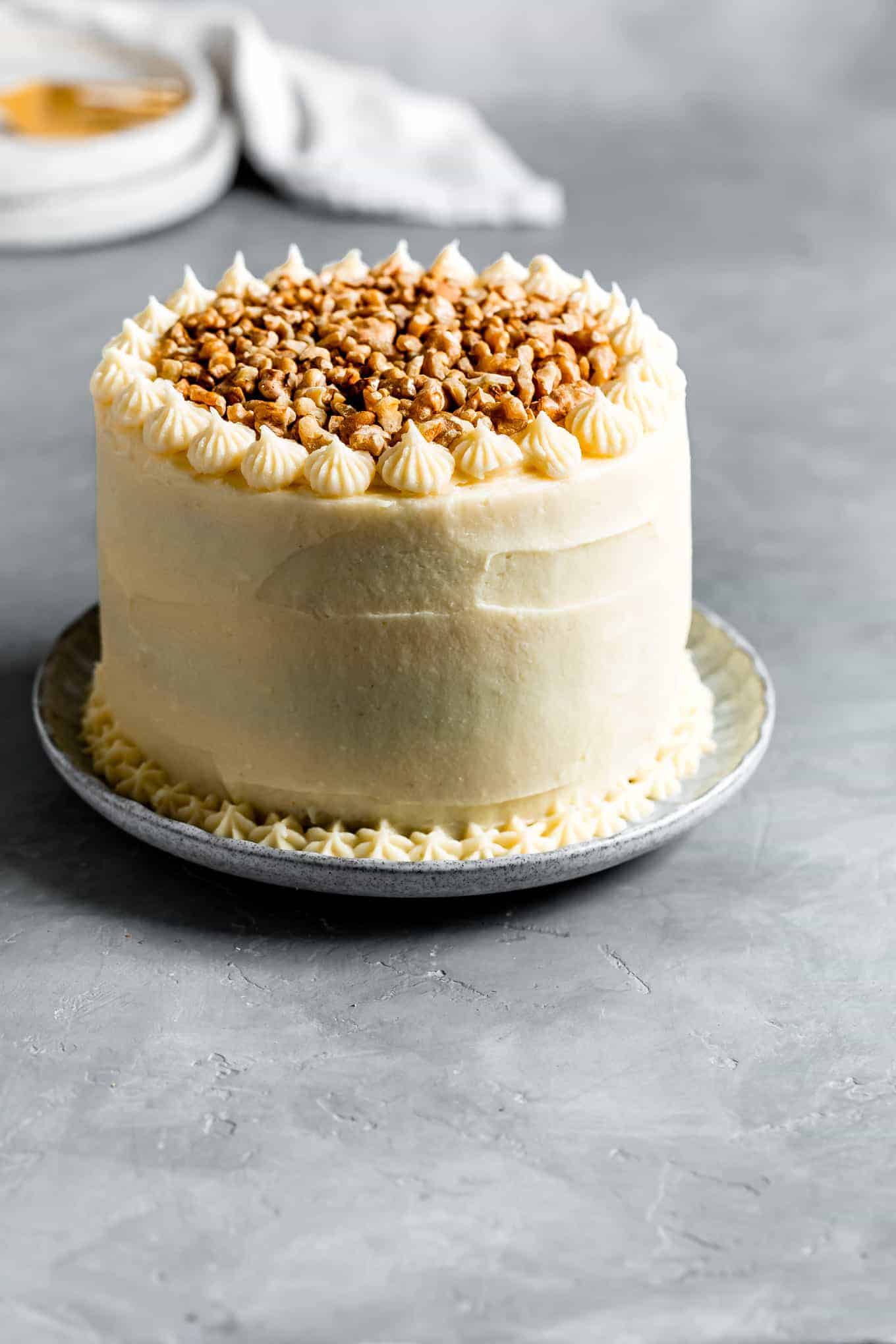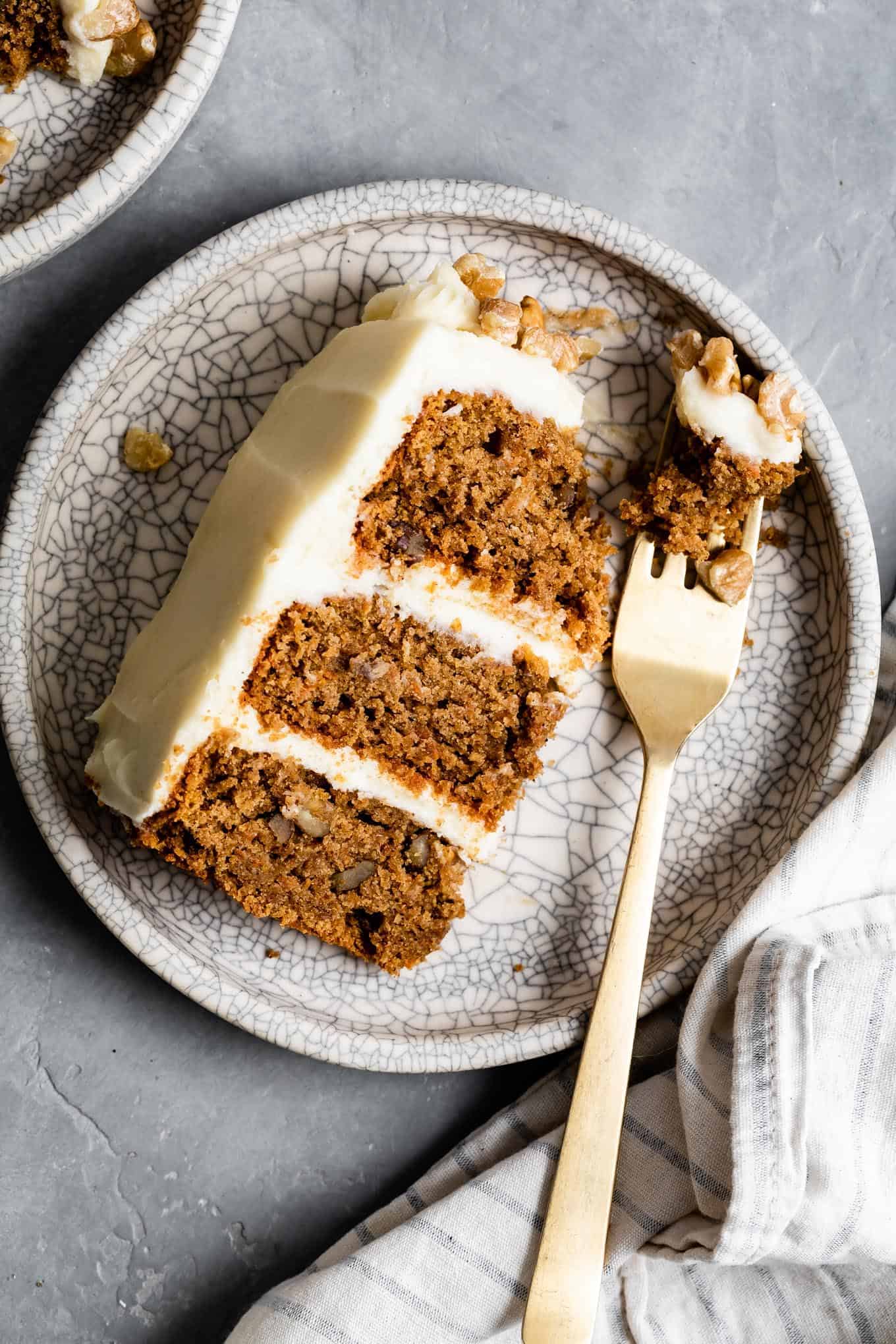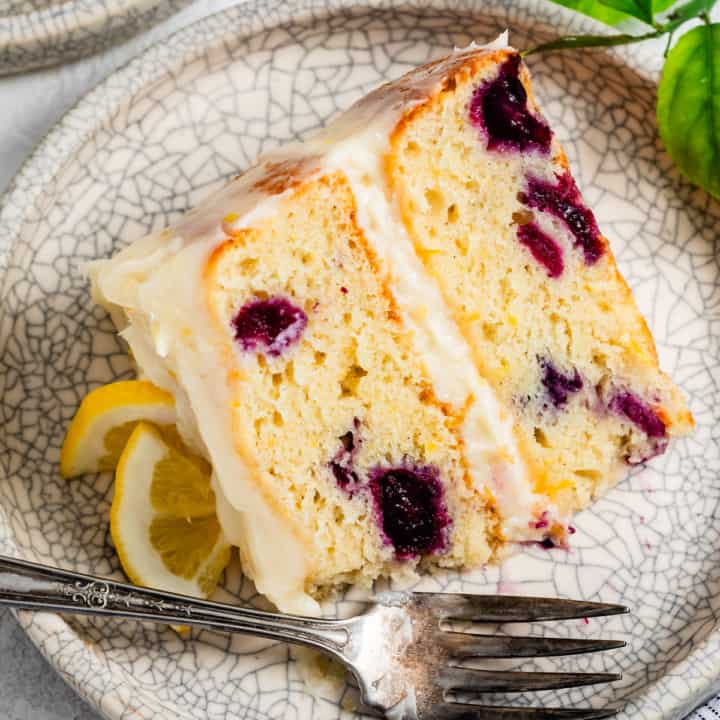Super moist gluten-free carrot cake with toasted walnuts and honey cream cheese frosting. This gluten-free carrot cake recipe has adaptations for substituting different gluten-free flours or small-batch!
Looking for a dessert recipe for this year's Easter-in-place or just a recipe to add to your stress-relief baking plans? I recommend this super moist gluten-free carrot cake! I've included adaptations for making it small-batch or with flours you have on hand to give you lots of options.
Carrot cake is a just-right cake for springtime, but with its warm wintry spices and root vegetables, it's also equally suitable for fall and winter. I also happen to know if you drop some off on your neighbor's porch, they'll love you even more.
Gluten-Free Carrot Cake Recipe
This gluten-free carrot cake recipe is an adaptation of my gluten-free carrot cake cupcakes posted many moons ago (6 years!!). I revamped the recipe in cake form last year and it's finally ready to share! This cake version uses fewer flours and cuts out the coconut for a simple old-fashioned carrot cake flavor.
Best Gluten-Free Carrot Cake
I love carrot cake. Probably because I love cream cheese frosting. Even a bad carrot cake can be made delicious with a slather of cream cheese frosting. I've even said before, "There’s something I feel very passionate about and it’s that carrot cake must have cream cheese frosting."
I'm a big fan of the carrot cake + cream cheese frosting duo, so if you can get your hands on cream cheese right now, do it.
That being said, I'm also backtracking just a bit. This gluten-free carrot cake is delicious in its own right. Completely naked. It does not need the cream cheese frosting. I know because, in my many tests of this cake, I ran out of cream cheese. Unable to get more on my grocery delivery, we ate an entire cake without frosting and pretended it was breakfast coffee carrot cake. It was incredible - moist, with warm spices, and crunchy toasted walnuts studded throughout.
Without frosting, you could even bump it up a notch and top it with a walnut streusel!
Gluten-Free Carrot Cake
Given the need to minimize grocery trips and bake from our pantries, I've tested this recipe a few different ways to give you flexibility!
Gluten-Free Flour Substitutions
Substitute with different flours depending on what you have in your pantry or can easily get your hands on!
Chestnut Flour Substitution: Chestnut flour is one of my favorite gluten-free flours. It's soft and sweet with roasted notes. In a cake, it bakes up fluffy and moist. It's also one of the hardest flours to come by because you won't find it at most supermarkets. This is the brand of chestnut flour I use and you can order it from a local market here in the Bay Area!
- Sub in by weight: Teff flour, millet flour, or all-purpose gluten-free flour. If you can't find chestnut flour, teff or millet flour work well! They are slightly less moist than the chestnut flour version, so add ½ teaspoon more coconut oil. They're also a bit more sensitive to overbaking, so be sure to pull the cake out promptly. The 8-inch cakes photographed below are made with teff flour and millet flour, respectively!
Gluten-Free Oat Flour Substitution: Oat flour helps create fluffiness and cakiness in a cake crumb. It also helps your baked goods stay moist.
- Option: grind up gluten-free rolled oats in a food processor or blender, then sift out any big pieces. Make sure to measure this by weight as homemade gluten-free oat flour is less finely ground so the volume per weight will be different.
- Sub in by weight: sorghum flour, or all-purpose gluten-free flour.
Sweet Rice Flour Substitution: I've said this before, but sweet rice flour is the most difficult flour to substitute in gluten-free baking. It’s the magic weapon for gluten-free baking as its stickiness helps to bind the baked good together and it lends to the chewiness of your cake.
- Sub in by weight: All-purpose gluten-free flour, equal parts chestnut flour and oat flour, or (possibly) tapioca flour. (Note: I have not tested gluten-free cake with tapioca flour in place of sweet rice flour, but it is what I would try first if you can't eat or get sweet rice flour.)
Small Batch Carrot Cake
This recipe makes a three-layer 6-inch cake. While, in pictures, a layer cake looks impressively large, this particular one is only 6-inches, so a family of four could easily finish it off in a couple of days.
If you don't have enough people in your house to eat a layer cake, don't let that stop you from enjoying carrot cake! You can also halve the recipe and bake it in an 8-inch pan for 26-28 minutes. Baked in an 8-inch pan, the cake won't be as tall and fluffy as you can see in the pictures, but equally delicious!
Gluten-Free Carrot Cupcakes
If you're after cupcakes instead, halve this gluten-free carrot cake recipe and bake it in a lined muffin tin to make 10 cupcakes.
More Gluten-Free Carrot Cake Inspired Recipes
- Gluten-Free Carrot Cupcakes with Coconut
- Carrot Cake Baked Oatmeal with Maple Cream Cheese Glaze
- Paleo Carrot Bread from The Movement Menu
- Carrot Cake Energy Balls from With Food & Love
- Gluten-Free Carrot & Zucchini Olive Oil Cake from Healthy Nibbles
- Gluten-Free Carrot Oatmeal Cookies from Salted Plains
Recipe

The Best Gluten-Free Carrot Cake
Ingredients
- 3 tablespoons whole milk, see substitution notes
- ¼ teaspoon white vinegar
- 58 g (½ cup) chestnut flour, see substitution notes
- 105 g (¾ cup + 3.5 tablespoons) gluten-free oat flour
- 121 g (¾ cup) sweet rice flour , different from "white rice flour" or "brown rice flour"
- 1½ teaspoons baking powder
- ½ teaspoon baking soda
- 1 teaspoon ground cinnamon, see substitution notes
- ¼ teaspoon ground nutmeg
- ½ teaspoon ground ginger
- ½ teaspoon kosher salt
- 123 g (½ cup + 2 tablespoons) light brown sugar, see substitution notes
- 26 g (2 tablespoons) granulated sugar
- 6 tablespoons (85 g) unsalted butter, room temperature
- 6 tablespoons (80 g) refined coconut oil, melted just below room temperature
- 2 large eggs, room temperature
- 1 teaspoon pure vanilla extract
- 1 tablespoons orange zest, from 1-2 oranges
- 300 g (2 cups) shredded carrots, from about 3-4 medium to large carrots
- ½ cup chopped walnuts or pecans, lightly toasted (optional, but recommended), plus more for decorating
- 16 oz (2 8-ounce blocks) full-fat cream cheese (blocked), room temperature
- 1 cup (2 sticks) unsalted butter, room temperature
- 3 cups powdered sugar, sifted
- 1 teaspoon pure vanilla extract
- ¼ cup honey
- Pinch of kosher salt
INSTRUCTIONS
Gluten-Free Carrot Cake
- Preheat the oven to 350°F and prepare three 6-inch cake pans by lightly rubbing with vegetable oil and lining with a round of parchment paper. Set aside. Alternatively, if halving the recipe, prepare a single 8-inch cake pan or line a muffin tray with 10 cupcake liners.
- Combine the milk and vinegar in a small measuring cup and set aside.
- In a medium bowl, whisk together the chestnut flour, oat flour, sweet rice flour, baking soda, baking powder, salt, and spices. Set aside.
- In the bowl of a stand mixer fitted with the paddle attachment or a mixing bowl with a hand mixer, cream together the sugars and butter until smooth and fluffy, 3-5 minutes. Add coconut oil and beat until smooth and scraping down the sides as needed.
- Add the vanilla and orange zest, mixing until smooth and scraping down the sides as needed. Add the eggs, one at a time, mixing until just combined and scraping down the sides as needed.
- Add the carrots and mix well to combine, scraping down the sides as needed.
- Add half of the dry ingredients in two parts alternatively with the milk and mix until just combined, scraping down the sides as needed. Fold in the walnuts.
- Divide between the three prepared baking pans, smoothing the top.
- Bake on the middle rack for 30-35 minutes until a toothpick inserted into the middle comes out clean or with just a few crumbs and the center springs back without leaving an indent when gently pressed.
- Let cool for 5 minutes before inverting onto a wire rack twice until upright to cool completely before frosting.
- Meanwhile, prepare the frosting.
Honey Cream Cheese Frosting
- In the bowl of a stand mixer fitted with the paddle attachment, cream the butter over medium speed.
- Add the cream cheese and beat until just smooth and combined.
- Add the powdered sugar, in thirds, mixing on slow speed until just combined. Take care not to overmix the frosting or it will become runny.
- Fold in the vanilla, honey, and salt until combined. If the cake is still cooling, chill the frosting for up to 30 minutes before frosting.
- When the cake is cool, stack the layers with ⅓ cup frosting spread evenly between each layer. Spread a thin layer of frosting over the entire cake and use an offset spatula or bench scraper to smooth it into thin crumb coat layer and chill for 10 minutes. Spread another layer of frosting all over the cake, smoothing with an offset spatula or bench scraper. If desired, pipe a ring of decorations around the bottom and/or top edge of the cake using your favorite icing tips. Decorate with toasted walnuts. Tip: Chill for 30 minutes to make slicing the cake easier! Store any leftovers in an air-tight container at room temperature for up to 2 days.
Notes
- Milk: Sub in 3 tablespoons buttermilk in place of the milk & vinegar
- Light Brown Sugar: Use organic light brown sugar or non-organic dark brown sugar. If using non-organic light brown sugar, add a teaspoon molasses.
- Chestnut Flour: Available online. Sub in by weight: Teff flour, millet flour, or all-purpose gluten-free flour. These options are slightly less moist than the chestnut flour version, so add ½ teaspoon more coconut oil. They're also a bit more sensitive to overbaking, so be sure to pull the cake out promptly.
- Gluten-Free Oat Flour: Available online. Option: grind up gluten-free rolled oats in a food processor or blender, then sift out any big pieces. Sub in by weight: sorghum flour, or all-purpose gluten-free flour.
- Sweet Rice Flour: Available online. Sweet rice flour is the most difficult flour to substitute in gluten-free baking. It’s the magic weapon for gluten-free baking as its stickiness helps to bind the baked good together and it lends to the chewiness of your cake. NOTE: I have not tested the following substitutions, but if you can't eat or get sweet rice flour, here are my recommendations to try. Sub in by weight: All-purpose gluten-free flour, equal parts chestnut flour and oat flour, or tapioca flour. If you sub out sweet rice flour, you may want to add 1 teaspoon xanthan gum.
- Spices: Replace all the spices with an equal amount of pumpkin pie spice, if that's what you have on hand.

























Alene -
I will make this, I am certain. I have lots of carrots and even cream cheese. But for tonight, I'm making a hazelnut flour cake from the New York Times for our lonely seder. We usually do the first one with about 250 people at our temple. But, obviously, that's not happening. Have a lovely Easter!
Tiffany -
Any chance you can put weights in for the sugar(s), oil, carrots, etc? Also can you sub coconut oil for any vegetable oil? Thanks!
Sarah Menanix -
No problem! Just baked another one and weighed the sugar, oil, and carrots - added above. I think you could sub in any vegetable oil for the coconut oil without any issues (though disclaimer that I haven't tried it). Goodluck!!
Norm -
Janet -
Can you substitute almond flour for chestnut?
Sarah Menanix -
Hm - Chestnut flour bakes up much softer and cake-like than almond flour and is much more finely ground. My guess is that almond flour would require some adjustments in liquid. It's possible almond flour would work, but I've never tested it so I can't say for certain! Sorry!
Chris -
Do you think AP flour be okay to substitute for the gluten free flours?
Sarah Menanix -
Do you mean gluten all-purpose flour or gluten-free all-purpose flour? While I haven't tried this recipe with either, my recommendation would be to sub out the flours by weight (the specific gluten-free flours have very different weight to volume ratios so subbing by volume would not be advised). If using gluten-free all-purpose flour, I recommend Bob's Red Mill 1-to-1 gluten-free flour!
mercmakesfood -
This quickly became my favorite carrot cake and I finally got chestnut flour to make it. Fun fact - DO NOT use tub cream cheese. The consistency is way different (especially Nancy's Probiotic Cream Cheese which I learned the hard way says "no thickener added"). The frosting will never set ever.
I'm still eating cake out of a bowl with frosting soup, though, so it's not a total loss.
Emmy -
Just to clarify, can this be baked in 2 8-inch cake tins instead of 3 6-inch tins? It looks absolutely delicious.
Sarah Menanix -
Yup! Baked in two 8-inch pans, you'll bake for 26-28 minutes. The layers won't be quite as tall and fluffy as in these pictures, but equally delicious!
Mary -
I made this cake yesterday. It really has a delicious flavor. Beautifully spiced. I didn't have 6" pans so baked in two 8" pans. I'm wondering about the bake though. The cake didn't rise much. The layers were fairly thin and the cake was dense. Since the cake was for a birthday and I didn't want it to look sad, I ended up making two more layers and made a 4 layer cake. It was beautiful looking but quite dense (and heavy with four layers). I wonder why the rise was so minimal. Is it supposed to rise more? I wonder if I did something wrong.
Sarah @ Snixy Kitchen -
Hi! The issue here is the pan size. Two 6” pans have a surface area of 56 square inches, whereas two 8” pans have a surface area of 100 square inches. So your layers would be almost half as thin if you baked in 8” pans. To convert to an 8” pan, bake just one layer instead of two (and maybe one cupcake:). I suspect that because the layers were so thin, this made it hard for the cake to rise properly with the nut/carrot add-ins.
Sarah @ Snixy Kitchen -
Oh - I’m sorry! I just realized you converted three 6” layers to two 8”inch layers. It’s early over here - haha. Sorry about that.
So your layers still won’t be as tall and fluffy in 8” pans because it’s 84” v 100”. But I have tested it in 8” pans so it should not be dense. Did your cake look like the photos here? If not, I wonder if it could have something to do with your leaveners being old? Did you measure by weight or volume?
Mary Ann Lynch -
My baking powder is indeed out of date. Mostly like the reason for the poor rise. Thanks for your response.
Tiffany -
I loooove this recipe (and all your recipes). You are such a gift to the GF community!
The honey cream cheese frosting is next level yummy, but it is quite loose when I make it - even after refrigerating. I can't get it to really hold any shape. Would you say it's naturally a soft frosting, or do you think I may be doing something wrong?
Thank you!
Sarah Menanix -
Hi! You are so kind - thank you! It is a naturally soft frosting - it will never firm up like buttercream, but if it's too soft that it won't hold its shape, my suspicion is that you overmixed the frosting, which will cause it to become much too runny. I'll add a note to ensure other folks also don't overmix the frosting! (Another issue that could cause a runny frosting is using low-fat cream cheese, which has more liquid.)